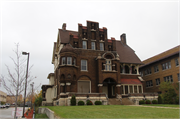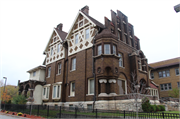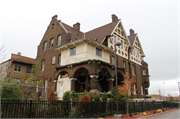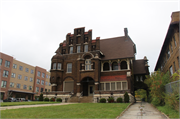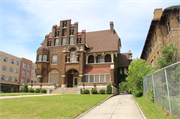Property Record
3424 W WISCONSIN AVE
Architecture and History Inventory
| Historic Name: | Henry and Marie Harnischfeger House |
|---|---|
| Other Name: | MARWALT APARTMENTS |
| Contributing: | |
| Reference Number: | 30276 |
| Location (Address): | 3424 W WISCONSIN AVE |
|---|---|
| County: | Milwaukee |
| City: | Milwaukee |
| Township/Village: | |
| Unincorporated Community: | |
| Town: | |
| Range: | |
| Direction: | |
| Section: | |
| Quarter Section: | |
| Quarter/Quarter Section: |
| Year Built: | 1905 |
|---|---|
| Additions: | |
| Survey Date: | 20042014 |
| Historic Use: | house |
| Architectural Style: | German Renaissance Revival |
| Structural System: | |
| Wall Material: | Brick |
| Architect: | Eugene R. Liebert |
| Other Buildings On Site: | |
| Demolished?: | No |
| Demolished Date: |
| National/State Register Listing Name: | Harnischfeger, Henry, House |
|---|---|
| National Register Multiple Property Name: |
| Additional Information: | A 'site file' exists for this property. It contains additional information such as correspondence, newspaper clippings, or historical information. It is a public record and may be viewed in person at the State Historical Society, Division of Historic Preservation. DESCRIPTION: The Henry Harnischferger House is a dark brown brick two and one-half story, pantile gable-roofed, German Renaissance Revival style mansion on a raised, rockfaced limestone terrace. The imposing structure, built in 1905, is sited in the middle of its 70 by 180 foot deep lot. There is a broad front lawn with landscaping limited to foundation plantings. The Wisconsin Avenue side is the principal elevation. It is elaborately composed of numerous projecting and receding elements including a corbelled oriel, a deeply recessed entrance, an arcaded loggia, a projecting sun porch and a massive panelled stepped gable. Extensive limestone trim accents the complex composition. The most distinctive feature of the facade is the second story loggia with its two columns carved in the shape of medieval knights. These were emblematic of the Harnischferger name which means "armor polihsher." The side elevations are utilitarian in design and are dominated by the soaring half-timbered gables. The porte cochere on the east side is surmounted by a chamber at the second floor with a parapet gable ornamented with limestone ball finials. C. A. Cleppe was its builder. With the exception of the replacement of the original sun porch casement windows with fixed glass and the installation of a new front door, the exterior of the house has been little altered. The garage/carriage house was demolished many years ago. ARCHITECTURAL/ENGINEERING SIGNIFICANCE: The Harnischferger House is architecturally significant as a fine and rare example of a German Renaissance Revival style mansion. It is the finest surviving example of this unusual, continental European late nineteenth century architectural mode in Milwaukee and displays superb craftsmanship. The house is probably the best remaining example of the domestic architecture of Eugene R. Liebert, one of Milwaukee's master architects at the turn-of -the-century. The German Renaissance Revival was a popular style among the city's wealthy German-Americans. Other residences in the style that are listed in the National Register are the Frederick Pabst House (1975) and the Joseph Kalvelage House (1978). The Harnischfeger House is distinguished from these by its abstraction of the traditional architectural forms, reflecting the influence of the German Jugendstil. This was noted by local architectural historian, Richard Perrin, as a movement towards a modern style, for its time, that was unmistakably German in its antecedents. The only other residence that was comparable to the Harnischferger House was the Herbert O. Trostel House, razed in 1935, on North Lake Drive. This residence was also designed by Liebert. (C). (See Historical Background for information on architect). HISTORICAL BACKGROUND: The Harnischferger House was built as the residence of Henry Harnischferger in 1905. Harnischferger (1855-1930) was a major Wisconsin industrialist whose firm, now known as the Harnischferger Corporation, has an international reputation in the manufacture of heavy construction and excavating equipment. Henry Harnischferger was born at Salmuenster, Germany, in 1855, a son of Konstantin and Christina (Adrian) Harnischfeger, who spent their lives in their native country where the father was born in 1817 and the mother in 1818. The former was for many years proprietor of a tanning business and passed away in 1889. Henry Harnischferger attended public schools in Germany and afterward learned the locksmith's trade. Attracted by the opportunities of the new world, he came to the United States in 1872. He arrived in New York and entered the employ of the tool department of the Singer Manufacturing Company at Elizabeth, New Jersey, remaining there one year. He next became an employee in the tool department of the Brown & Sharpe Manufacturing Company at Providence, Rhode Island, and remained with that concern for eight years. In 1881, Mr. Harnischferger moved to Milwaukee and was assigned the position of foreman of the milling machine department of the Whitehill Sewing Machine Company. While thus engaged, he met Alonzo Pawling and the latter's first partner, Moritz Weis, who were then associated in business under the name of the Milwaukee Tool and Pattern Works. In 1884 Harnischfeger purchased the interest of Mr. Weis in the business and the name was then changed to Pawling and Harnischfeger. Eugene R. Liebert (1866-c.1930s) was an important Milwaukee architect who designed some of the city's most distinctive buildings. Born in Germany in 1866, he immigrated to Milwaukee in 1883 after receiving some architectural training in Berlin. He became associated with Koch & Schnetzky architects and succeeded to a partnership after Koch's retirement in 1890. Schnetzky subsequently retired from the firm in 1897, and Liebert carried on the business alone. Liebert either designed or collaborated on many important commercial buildings while with Schnetzky including the Germania Building (listed in the National Register-1983) and a considerable number of large residences. On his own he designed a large number of houses, the finest of which was the Alber O. Trostel House, 3200 North Lake Drive (built 1908), possibly the largest and most expensive residence ever constructed in Milwaukee. The Trostel House was a much grander version of the Harnischfeger House, which it resembled. Since the demolition of the Trostel House in 1935, the Harnischfeger House has been the finest example of Liebert's highly accomplished domestic architecture in Milwaukee. Liebert's firm was active into the 1930s and designed Henry Harnischfeger's Terrace Avenue residence in 1926. (D). HISTORICAL SIGNIFICANCE: The Harnischfeger House is historically significant for its association with Henry Harnischfeger (7/10/1855-11/15/1930), a major Milwaukee industralist, who made important contributions to advancing heavy construction technology. Harnischfeger lived in this house for most of his adult life during the period when his company made its most significant innovations. (D, E). Harnishchfeger was born in 1855 in Salmuenster, Kreischlichten, Hessen, Nassan Germany. Apprenticed as a locksmith he came to New York City in 1872 where he assumed various jobs which dealt in the repair and maintenance of machinery. He came to Milwaukee and worked for the pioneering Whitehall Sewing Machine Company from 1881 until it went out of business in 1884. He formed a partnership with Alonzo Pawling in the same year to form Pawling Harnischfeger Co.; a tool and die works. Pawling sold his interests in 1911 and the company was renamed Harnischfeger Corporation until 1924. The principal product was traveling cranes and excavating machinery. Harnischfeger established a foundation in 1929. He died in 1930. Locally designated: 2-15-1983. Strachota was the builder. According to R.W.E. Perrin, the Harnischfeger house and others similar are a result of abstract German Traditional architectural forms combined to produce a unique modern style for its day. Perrin notes the front stepped gable and half timbering in the gable ends as earmarks of the style. A curious feature is the knights in armor columns found on the second story porch. They are assumed to be symbolic of the Harnischfeger name which means armor polisher. Henry Harnischfeger was an outstanding industrialist and civic leader. A native of Salmuenster, Kreischlichten, Hessen, Nassen Germany he was born in 1855. Apprenticed as a locksmith he came to New York City in 1872 where he assumed various jobs which dealt in the repair and maintenance of machinery. He came to Milwaukee and worked for the pioneering Whitehall Sewing Machine Comapny from 1881 until it went out of business in 1884. He formed a partnership with Alonzo Pawling in the same year to form Pawling and Harnischeger Co.; a tool and die works. Pawling sold his interests in 1911 and the company was renamed Harnischfeger Corporation until 1924. The principle product was traveling cranes and excavating machinery. Harnischfeger established a foundation in 1929. He died in 1930. Cleppe was the builder. Strakota was the mason. Previously surveyed in 1984 with map code 101/31. Map name was LUQS 388. 2015- "The Harnischfeger House is located at 3424 W. Wisconsin Avenue and is situated near the center of a long, rectangular parcel that faces south onto W. Wisconsin Avenue. The east side of the lot has a long concrete driveway that leads through the porte cochere and to rear of the property, the majority of which is paved. Four concrete stairs lead from the public sidewalk up to the wide central walk that leads to the main entrance of the house. Small shrubs are planted near the facade of the building. At the east property line is a modern, chain-link fence that separates the house from a mid-1920s apartment building. The west property line is a short, concrete retaining wall separating the house from a modern Veteran's Affair building. At the north (rear) property line is a modern, chain-link fence that separates the property from the house to the north that fronts W. Wells Street. Historically a large stable was located at the rear of property, but has since been demolished. The Harnischfeger House, constructed in 1905, is an excellent example of the German Renaissance Revival style and was designed by Eugene R. Liebert. The Harnischfeger House is a two-and-one-half-story home clad in dark brown brick with limestone accents, resting on a raised limestone foundation. It has an irregular roof comprised of multiple gables; two peaked gable faces west and a single clipped gable faces east, while a central, prominent steeped Flemish gable featuring three windows and decorative arches dominates the main (south) facade. Decorative brickwork is featured below the gables. The roof was historically clad in red clay tile, but currently has asphalt shingles. An open porch, with brick and limestone railings, spans the front of the house. At the west corner of the facade is a large, five-sided oriel window supported by brick and limestone columns. At the east corner of the facade is a one-story porch, or solarium, which features a ribbon of five, fixed, single-paned windows. It has a shed roof that is clad in red clay brick, which covered up original small skylights. The recessed main entrance is centered on the front facade and is located within a two-story decorative brick and limestone arch supported by brick columns with an iron king post detail. The arch has decorative limestone coping, with flanking limestone orbs. Four windows surrounded by columns and topped by an oculus window are located above the entrance. To the west of the entrance is a large, plate-glass window that is not original to the house. The second story features a recessed open porch that is supported by decorative wood columns, two of which feature carved wood knight figures. Windows are a mix of large, plate glass with a brick-arched lintel, and one-over-one, double-hung, sash replacements with limestone lintels. The side (east) elevation has a clipped gable with a central oculus window. An intact porte cochere with a second-story living space is centered on the elevation. It is supported by square brick columns and covered by a steep side gable roof with decorative limestone details along the parapet. Two narrow arched window openings with double-hung replacements are centered on the second floor. The archway of the porte cochere has iron king post details that match those at the entrance. A side entrance to the house is located within the porte cochere. It features twin staircases of limestone with a simple metal railing. Two arched brick alcoves flank the entrance, which features a door flanked by two window opening with stone sills. They have been boarded up with plywood. The original door has been removed and replaced with a metal replacement. Windows on the first floor of this elevation are large, single-pane replacements. Other windows are one-over-one, double-hung, sash replacements. The rear (north) elevation has a steeped parapet roofline, with a central oculus window in the gable. A large, open porch is located at the northwest corner. It has a flat roof that is supported by brick columns with limestone capitals and king post details. A portion of the porch has been enclosed and openings has been plastered over. A square, second-story addition above the porch has a flat roof with decorative wood brackets and replacement windows. Windows on this elevation are a mix of casements, glass block, and double-hung replacements. One window has been enclosed with brick and the basement windows have been covered. An additional entrance is located at the northeast corner of the rear. It is a modern, metal replacement door. The side (west) elevation has two gable ends with central oculus windows with trefoil details, half-timbering, and vergeboards. Centered on each gable end are large, brick chimneys. Two, three-sided projecting bay windows are also situated toward the rear of the building. Despite numerous attempts to contact the current owner, the interior of the building was not accessible at the time of the survey; however, a property listing for the house was found on loopnet.com, which featured interior photos of the house. It is unclear when these photos were taken. The photos show that the interior has undergone a number of changes, such as the addition of kitchen spaces on the second and third stories, and the addition of drop ceiling, carpet, and updated lighting. However, the first floor appears to retain most of the original layout, as well as some of the original door frames, coffered plaster ceilings, fireplaces, and other woodwork." -"Henry and Marie Harnischfeger House", WisDOT #2190-00-00, Prepared by Mead & Hunt, Inc. (2015). 2014- "The Henry Harnischfeger House is a large German Renaissance Revival mansion constructed in 1905 and designed by German-American architect Eugene R. Liebert. It is a two-and-one-half-story home clad in dark brown brick with limestone accents, resting on a raised limestone foundation. It has a side gable roof with a central prominent, steeped Flemish gable featuring three windows and decorative arches. The roof was historically clad in red clay tile, but currently has asphalt shingles. However, the clay tile has been preserved in the Flemish gable and a historically enclosed porch on the first story. At the west corner of the main (south) facade is a large, two-story, five-sided oriel bay supported by brick and limestone columns. The recessed main entrance is centered on the front facade and is located within a two-story decorative brick and limestone arch supported by brick columns with an iron king post detail. At the center of the arch are four windows. To the west of the entrance is a large, plate glass window, likely not historic. The second story features a recessed open porch that is supported by decorative wood pillars, two of which have carved wooden knights. The side (east) elevation has an intact, two-story, brick porte cochere. It is supported by square brick columns and covered by a steep side gable roof with decorative limestone details along the parapet. The other side (west) elevation has decorative wood and brick half-timbering in the gable ends. Also, centered on each gable end are large, brick chimneys. Two, three-sided projecting bay windows are also situated toward the rear of the building. The rear (north) elevation features a large, open air porch at the northwest corner. It has a flat roof that is supported by brick columns with limestone capitals. A portion of one of the openings has been plastered over. A square, second-story addition on the porch roof has a flat roof with decorative wood brackets, and replacement casement windows. Henry Harnischfeger was born in Germany in 1855 and immigrated to the United States in 1872. In 1881 he moved to Milwaukee to work as a foreman in a milling machine department. Soon after, he purchased ownership in a machinery business that became known as Pawling and Harnischfeger. In 1887, after securing a contract with Allis-Chalmers to build the first three-motor electric traveling cranes, the firm focused on manufacturing cranes. By 1922 the plant covered 400,000 square feet of floor space on 28 acres, and was one of Milwaukee’s largest industrial complexes (1). In 1905 Harnischfeger hired German architect Eugene R. Liebert to design his stately house on West Wisconsin Avenue. Harnischfeger and his family lived in the house until 1926, when a smaller house also designed by Liebert was constructed on the city’s east side. By then West Wisconsin Avenue had transitioned from a sedate residential street of mansions, to a busy, congested avenue with multiple apartment buildings, and Harnischfeger disliked the change in character. Harnischfeger died in 1930 (2). After 1926 the house was divided into apartments." -"W Wisconsin Ave, 20th St-35th St", WisDOT #2190-00-00, Prepared by Mead & Hunt, Inc. (2014). |
|---|---|
| Bibliographic References: | A. Milwaukee City Building Permits. B. Milwaukee City Directories. C. Perrin, Richard W.E., "Milwaukee Landmarks," 2nd ed. Milwaukee: Milwaukee Public Museum, 1979, pp. 115-116. D. Gregory, John G., ed. "History of Milwaukee, Wisconsin," Vol. 1, Milwaukee: S.J. Clarke, 1931, pp. 109-10, 337-338. E. Old Setlers Club, Milwaukee County Historical Society, "Obituaries-Book Z," p. 264. (Scrapbook). F. Snook, Carol and S. Devitt. "The Menomonee Valley Industrial Survey-224-28 South First Street," Unpublished historical survey of Milwaukee's industrial buildings in the Menomonee Valley, State Historical Society of Wisconsin, 1979. Perrin, p. 95. ZIMMERMAN, 238. MILWAUKEE ETHNIC HOUSES TOUR, CITY OF MILWAUKEE DEPARTMENT OF DEVELOPMENT, 1994. BUILT IN MILWAUKEE, LANDSCAPE RESEARCH, P. 168. MILWAUKEE JOURNAL 12/20/1994. MILWAUKEE JOURNAL 12/16/1994. MILWAUKEE HISTORIC BUILDINGS TOUR: WEST END, CITY OF MILWAUKEE DEPARTMENT OF CITY DEVELOPMENT, 1994. MILWAUKEE JOURNAL SENTINEL 7/2/1995. MILWAUKEE JOURNAL SENTINEL 10/25/1995. MILWAUKEE DAILY REPORTER 10/26/1995. MILWAUKEE JOURNAL SENTINEL SECTION E 11/6/1996. 2014 (1) West Side Neighborhood, Historic Resources Survey, City of Milwaukee, Department of City Development, 49-50. (2) West Side Neighborhood, Historic Resources Survey, City of Milwaukee, Department of City Development, 13-47, 13-48; Milwaukee Historic Preservation Commission, “Historic Designation Study Report: Henry Harnischfeger House,” Winter 1990-91, http://www.city.milwaukee.gov/ImageLibrary/Groups/cityHPC/DesignatedReports/vticnf/HarnischfegerHouse.pdf (accessed 22 December 2014). |
| Wisconsin Architecture and History Inventory, State Historic Preservation Office, Wisconsin Historical Society, Madison, Wisconsin |

